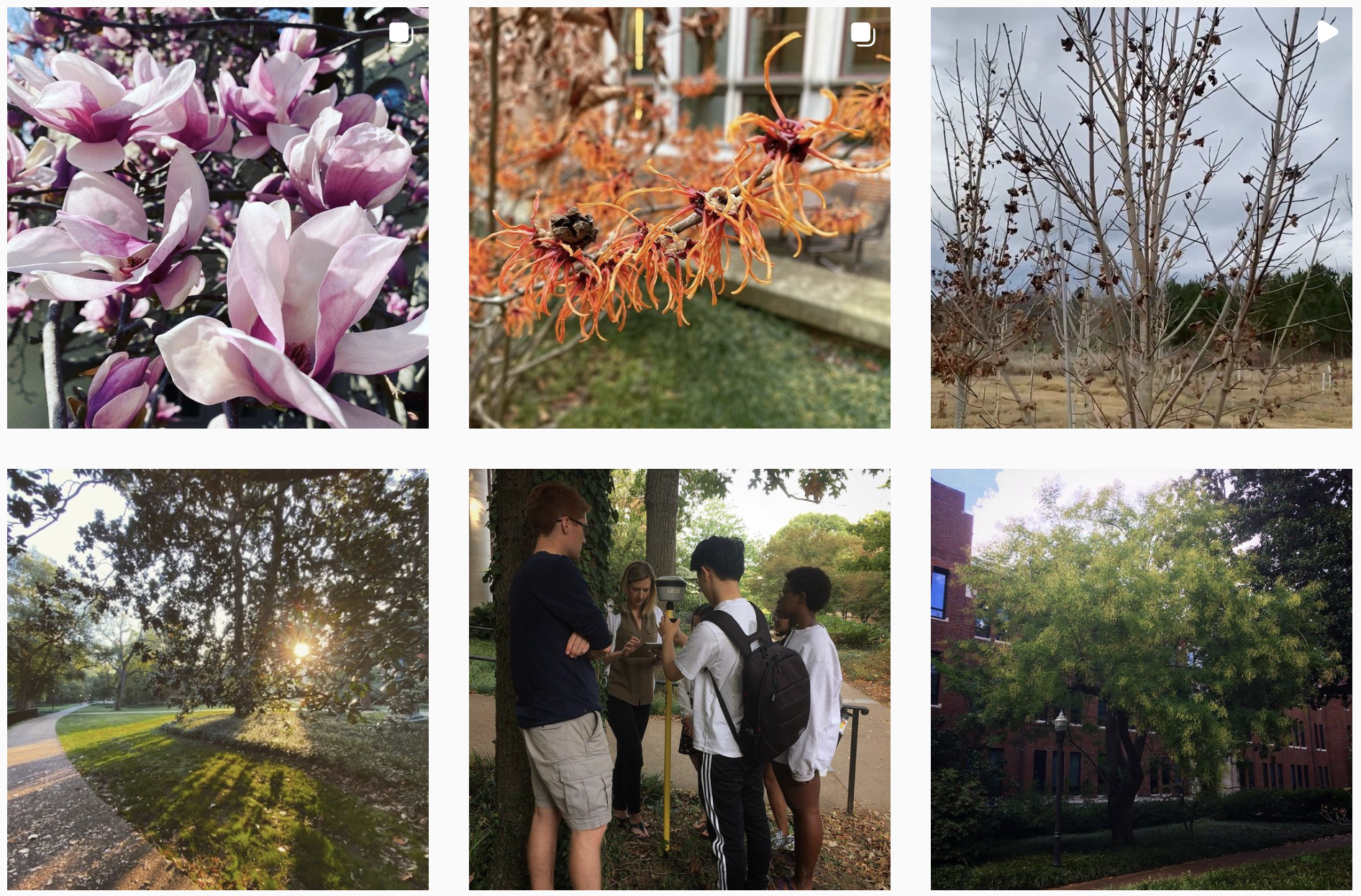Recent News
- WATCH: 5 Things You Didn’t Know About Vanderbilt’s West End Neighborhood
- Vanderbilt University Native Meadow flourishing with collaborative research projects
- Signs of spring: VU Arboretum grows by 35 trees
- New segment of Walk & Roll Loop opens on campus
- WATCH: 5 sustainability efforts you may not know about at Vanderbilt (Part Two)
- Vanderbilt’s magnolia trees and the women who planted them
LEARN MORE about the history of Vanderbilt’s trees
Vanderbilt campus at the beginning
In March of 1873, Bishop Holland McTyeire convinced Cornelius Vanderbilt to contribute half a million dollars to found Vanderbilt University. In May of that year, he negotiated the purchase of several tracts of mixed residential and farm land located on a small hill west of Nashville.1 “It had been a farm. There were two buildings – houses at the time. One is still there, and is called Old Central. … There was another big house where Hane Litton Tayor had lived, about where the Harold Vanderbilt statue is now. It was torn down when they built old Wesley Hall in the early years. Part of [the land] had been a corn field, and part had been a nusery for plants and flowers”.2
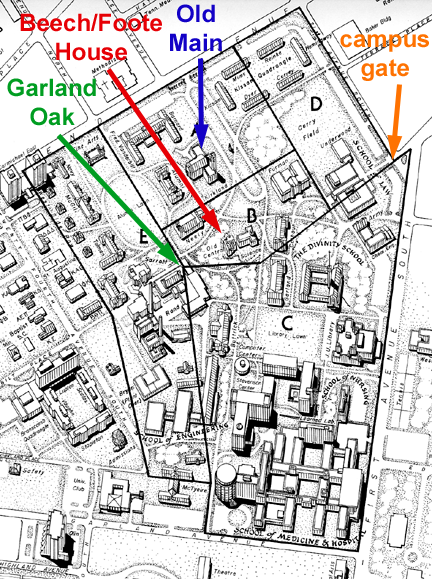
PROPERTIES PURCHASED TO FORM VANDERBILT.
map source: R. A. McGaw, The Vanderbilt Campus: A Pictoral History, copyright 1978, Vanderbilt University Press, p.17.
Except along roadways, there were very few trees. (See an analysis of trees that predate the campus for more information). A notable exception was the area near the farm residence (Old Central) which had been the home of A. B. Beech and before that the Henry Foote family.3 Near this building were several large oaks that have been significant in the history of Vanderbilt. To the west was the “Garland Oak”, a large overcup oak that was mentioned in early deeds because it marked the corner of three of the tracts purchased by McTyeire. It received its name because it grew near the home of the university’s first chancellor, Landon Garland, who put squirrel boxes in its branches.4 To the south was the large bur oak known as the Bicentennial Oak, which still stands in the greenspace between Garland Hall and Rand. Another large bur oak stood closer to the back porch of Old Central.

source: Vanderbilt University Special Collections and University Archives photo PA.BLD.KIRH.102
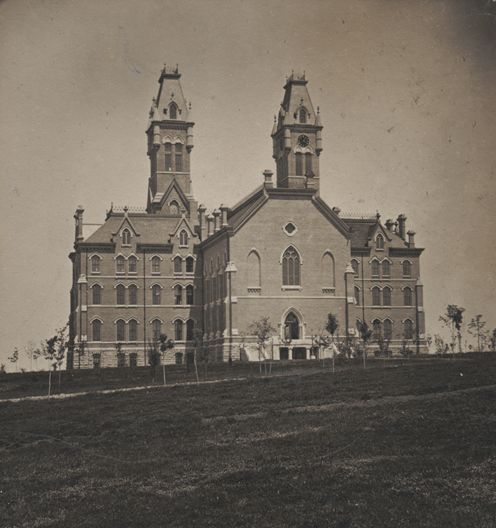
source: Vanderbilt University Special Collections and University Archives photo PA.BLD.KIRH.002
Bishop McTyeire served as president of the Board of Trust for life as part of the conditions stipulated by Cornelius Vanderbilt. McTyeire lived in the Beech house while the main campus building (“Old Main”; now Kirkland Hall) was constructed. He immediately began to shape the character of the campus through a massive tree-planting campaign. All around Old Main (the only academic building on campus at that time), McTyeire supervised the planting of hundreds of small trees, which can be seen in the photographs above. In a letter dated November 24, 1873, he reported to Vanderbilt that he had 200 trees planted around the grounds that month.4a
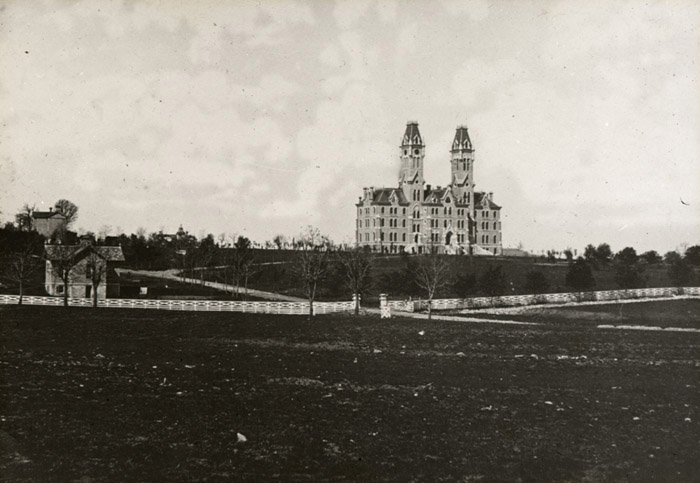
VANDERBILT CAMPUS C. 1875
source: Vanderbilt University Special Collections and University Archives photo SC.MSS.0332.073
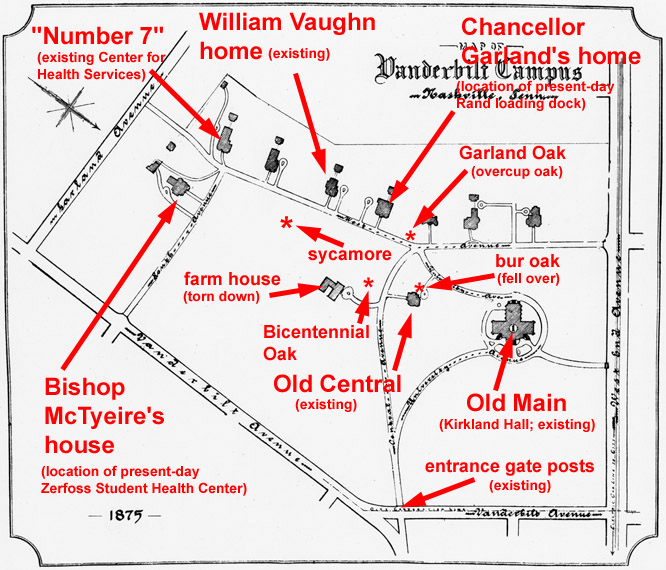
MAP OF VANDERBILT CAMPUS IN 1875 WITH KEY LOCATIONS IDENTIFIED
map source: Vanderbilt University Special Collections and University Archives photo PA.CAF.MAMO.001
The trees were an evident source of pride for McTyeire. Stella Vaughn, who grew upon campus as the daughter of mathematics professor William J. Vaughn and later becamse the unofficial dean of women, recalled in her unpublished memoirs that Bishop McTyeire “took his exercise by walking over the campus watching the growth of the trees whose planting he had supervised.”5 She also remembered that “when the Bishop would see me at play he would call me to him and take me by the hand and say, ‘Now, I’m going to see how many trees you can tell me the names of.’ When I was in doubt he would tell me, then he would say, ‘The next time I see you I will ask you the names of more trees.’ “6
There were several large trees near the Vaughn home which may have been there before the founding of Vanderbilt. This includes a large sycamore that is still at that location (now the Steven Center courtyard) today.
The Vanderbilt Arboretum
It is evident from the quote above that McTyeire considered the trees he was planting to have an educational purpose in addition to an asthetic one. This educational mission was reflected in the designation of the campus grounds as “the Arboretum” as early as 1878.
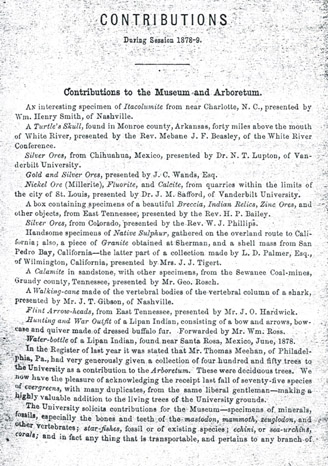
FROM “VANDERBILT UNIVERSITY CONTRIBUTIONS 1878-79”
source: Vanderbilt University Special Collections and University Archives
Under the direction of Dr. Safford, Professor of Botany, and the landscape gardner, Mr. D. Douglass, donations of many species of trees were accepted and planted in the arboretum. Over 500 trees were donated by Thomas Heehan and were systematically recorded in a Catalogue of the Species and Varieties of Plants in the Vanderbilt Arboretum in May of 1879. Some of these trees were probably the ones McTyeire quizzed Stella Vaughn on in about 1882 or 83.
Although we don’t know for sure which of the many large trees in the old campus were part of this initial planting campaign, it has been noted that the Tennessee state champion Japanese zelkova tree was planted by Bishop McTyeire near the original entrance to the campus.7
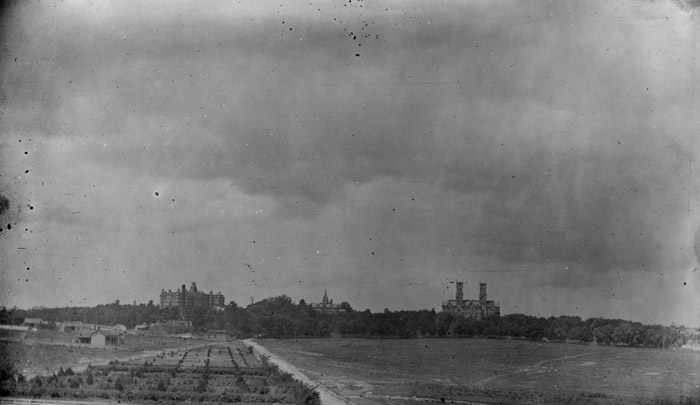
VANDERBILT CAMPUS 1890-1900
source: Vanderbilt University Special Collections and University Archives photo PA.CAF.SCEN.001
By 1890, the campus was an island of trees, still surrounded by a sea of agricultural fields.
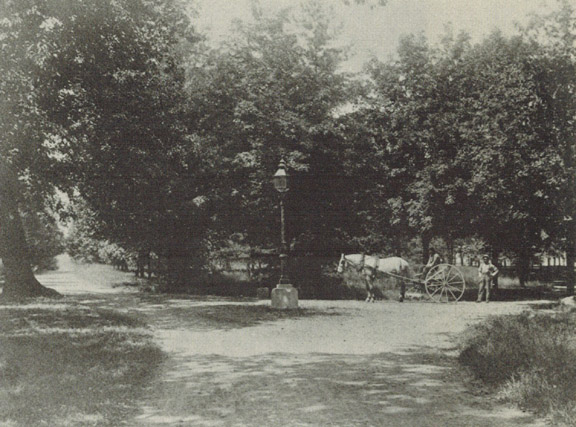
THE FAMOUS GARLAND OAK (LEFT) AND GROUNDSKEEPERS. (LEFT) DAVID DOUGLAS ON HORSE-DRAWN RAKE, FIRST SUPERINTENDENT OF GROUNDS, (RIGHT) VIRGIL HENLEY, ASSISTANT. KIRKLAND HALL VISIBLE IN DISTANCE ON RIGHT. PRESENT DAY LOCATION: RAND TERRACE FACING WEST END AVENUE.
source: Photo by Harry S. Vaughn in early 1900s. From the Vaughn Collection, Vanderbilt University Photographic Archives in McGaw, Robert A. 1978. The Vanderbilt Campus: A Pictoral History, Vanderbilt University Press, Nashville, p. 139.
Unlike the campus of today, the grounds was not maintained and mowed regularly. A campus visitor remarked “the ‘buildings and grounds man’ had a horse-drawn mower and a horse that he stabled on the Vanderbilt campus. The campus then was closed all summer because it was just too hot for classes. He let the grass grow during summer to make hay for the horse, and fed it all winter on the hay.”8
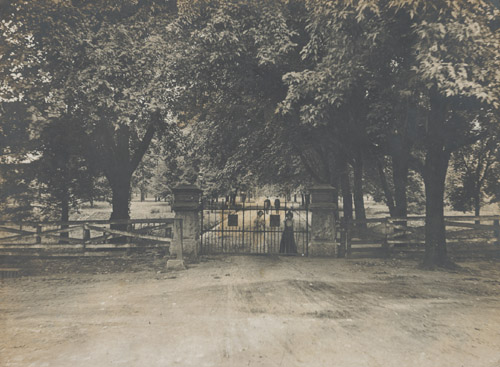
BROAD STREET ENTRANCE TO VANDERBILT CAMPUS 1900
source: Vanderbilt University Special Collections and University Archives photo PA.CAF.GATE.001
By 1900, the trees flanking the main entrance to campus (which were small trees in the 1875 picture) had matured. Although it can’t be known for sure if these any of these trees are the ones still growing along 21st Avenue, the stone gateposts can still be seen along the sidewalk in front of the Law School.
Students had already become attached to the trees on campus by the time Furman Hall was built in 1907. “In the first such controversy on campus, students protested the cutting of large trees near Furman, purportedly to allow motorists on West End to view the new masterpiece.”8a
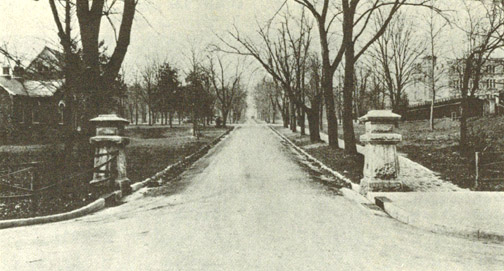
BROAD STREET ENTRANCE TO VANDERBILT CAMPUS 1917. NOTICE THAT THE ENTRANCE HAS BEEN WIDENED TO ACCOMMMODATE CARS. ALSO NOTE THE TWO MISSING TREES BETWEEN THE CAMERA AND FURMAN.
source: 1917 Commodore, p.17 in McGaw, Robert A. 1978. The Vanderbilt Campus: A Pictoral History, Vanderbilt University Press, Nashville, p. 62.
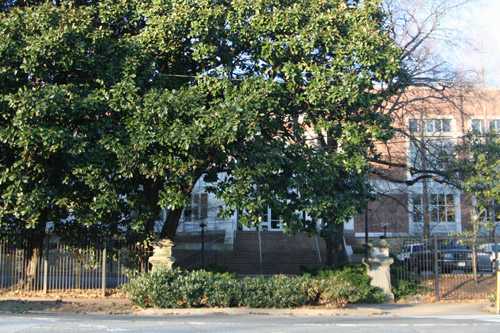
ORIGINAL VANDERBILT GATES IN 2014. THE LAW SCHOOL NOW BLOCKS THE ORIGINAL ENTRANCE ROUTE.
Photo by Steven J. Baskauf – CC BY
The Vanderbilt Garden Club
James Kirkland, who became chancellor in 1893, was an ardent gardener. He kept a large garden at the chancellor’s residence (the former home of Bishop McTyeire) and became an ardent breeder of irises. He and several other figures associated with Vanderbilt won Dykes Medals for the varieties that they bread. Chancellor Kirkland’s wife, Mary Henderson Kirkand, was instrumental in founding the Vanderbilt Garden Club, a group of women who were interested in improving the appearance of the campus. The Club was founded in about 1927 and was limited by invitation only to 25 members.9 Despite Mrs. Kirkland’s involvement with the club, there were occasional conflicts when the Club’s plans clashed with those of the adminstration. Initially, the Club was focused primarily on planting flower beds and shrubs. In about 1928, Alieen Bishop suggested that the club should follow the example of Bishop McTyeire and add to the trees on campus. From that point through the 1990’s the club was instrumental in planting many trees on campus.10
The postwar Garden Club was revitalized by the arrival of Margaret Branscomb, wife of the new Chancellor Harvie Branscomb. The Branscomb administration presided over a massive building campaign and the Club was regularly involved in organizing the planting of trees to beautify the areas around the new buildings in consultation with Superintendent of Grounds Jack Lynn.11 Major tree-planting efforts included supporting the magnolia screen on the campus perimeter during the 1950’s (below) and plantings around the new Branscomb Quadrangle during the late 1960s. By that time, the campus plantings were coordinated exclusively through Plant Operations and the Garden Club had evolved into a supporting role. The Garden Club continued to meet until the fall of 2006 when it decided to disband given that landscaping on campus was being done by professional crews.12
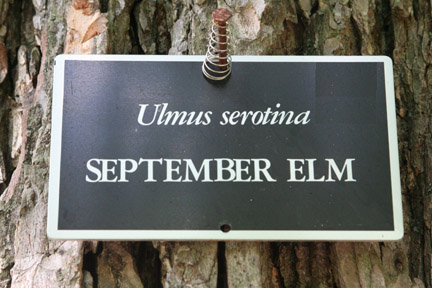
Tree Labels and the Mapheus Smith Endowment
A well-known feature of the Vanderbilt arboretum is the labels that are found on many of the trees on campus. This effort began as a project of the Vanderbilt Garden Club in 1953, along with the first complete inventory of trees since the 1879 list. Mrs. S. R. Schealer chaired a committee which included representation of the Biology faculty: “Mrs. Ernest Goodpasture, Dr. Elsie Quarterman, Dr. George Mayfield, and assistance from Dr. Harold Bold. These gave generously of their time and considerable thought to the needs of the Vanderbilt campus; especially to the project of labeling the trees on campus.
We divided the campus into sections and spent three days counting, checking and listing all the trees. Since this work was carried on during the winter months (due to the idea of marking them the following spring and summer) the program was especially difficult due to the fact that the trees were not in leaf, and without the aid of these specialists I feel the work could not have been finished on schedule. … This list13 was complete and up to date as of June 1, 1953. On February 1, 1954, Dr. Bold planted two new species on the campus (an Umbrella tree and a Cork oak), and Mrs. Goodpasture added a Chinese Scholar tree.
The committee also gave considerable thought and discussion to a list of trees to be added in the near future to the campus. This was based on a study of the old original Vanderbilt listing as to replacement as well as to variety, climatic conditions and the shortage of some species and usefullness to the teaching staff of the Biology Department.”14
This effort had two tangeable results. The club donated $50 to buy several hundred plastic markers that were placed on trees by the Beta Beta Beta Club (a biology honarary society) under the direction of Dr. Quarterman. Thus began the tree-labeling effort that has continued until today. The other result was that a number of trees on the list were acquired and planted.The Chinese scholar tree mentioned in the report was planted in front of Buttrick Hall (the biology building) and was eventually declared a Tennessee State Champion Tree (although it is now dethroned). Also planted around Buttrick were two red buckeye trees flanking the front door, and an American smoketree behind the building (cut down when the addition was added to the back side of Buttrick). A horse chestnut tree was planted next to the main library building, and bigleaf magnolias were planted between Garland and the Divinity School.
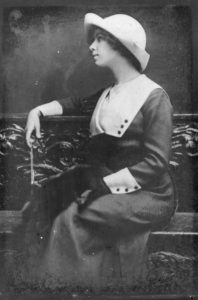
WILL ELLA (WILLA) TATUM (MRS. JAMES MAPHEUS SMITH) IN THE EARLY 1900S. SHE WAS A LIBRARIAN AT VANDERBILT FROM 1922 TO 1931 AFTER WORKING AT THE LIBRARY OF CONGRESS, AND WAS REPORTED TO HAVE DATED ROBERT PENN WARREN BEFORE MARRYING DR. JAMES MAPHEUS SMITH.
source: Joel Tatum (nephew of Willa), used with permission.
In 1968, Mrs. James Mapheus Smith donated $15,00015 to establish an endowment16 in memory of her husband to support tree labeling and planting.17 18 This fund has supported the purchase of the hundreds of aluminum labels that have been attached to the trees on campus. As the tree grows, the coil springs that surround the nails keeps the label in position without damaging the tree.
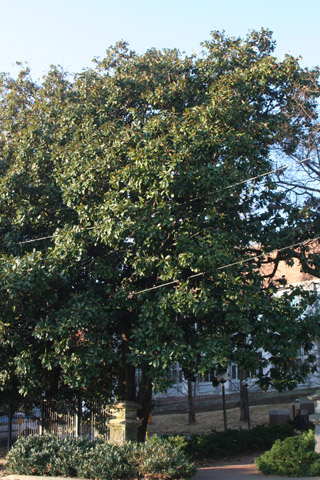
MAGNOLIA SCREENING THE LAW SCHOOL FROM 21ST AVENUE S. THIS MAY HAVE BEEN ONE OF THE TREES TENDED BY MARGARET BRANSCOMB.
Photo by Steven J. Baskauf. Click on the image for further information.
Magnolias
The many magnificent southern magnolias are one of the prominent features of Vanderbilt’s campus today. Southern magnolias had been planted on campus since the 1870s and the species is listed in the 1879 catalogue of the arboretum. There are a number of individual magnolias that are known to be at least 100 years old. The magnolias that surround Bishop McTyeire’s grave were probably part of the original plantings of the campus. Chancellor Kirkland noted in his 1893 inaugural address that “under the shade of magnolias that his own hand planted, he sleepeth well”.19 There are also a number of large magnolias that are recognizable on the first aerial photos of campus taken in the 1920’s. These include 5 magnolias along the north side of Magnolia Circle and a large magnolia in front of Buttrick Hall.
The “circle of magnolias” that surrounds the campus was the brainchild of Margaret Branscomb who suggested the idea while she was president of the Vanderbilt Garden Club in 1954. “I think that the Garden Club must have been the only group that cared what the campus looked like. A busy city street ran across the campus, and it was exposed on all sides to city traffic. … I was impressed by seeing so many beautiful magnolia trees in Nashville, and thought of the noise and dust a think row of magnolias would lessen, to say nothing of the campus being so open to the public view.”20 The circle of magnolias did with trees what Edward Stone’s 1947 campus plan did with buildings. Chancellor Branscomb presided over a massive building campaign based on Stone’s plan that placed new buildings around the perimeter of the campus.21 The screen of trees and buildings helped to create the distinctive and peaceful environment in the center of Vanderbilt campus that often surprises visitors to the urban campus.
The Board of Trust and the Buildings and Grounds Department enthusiastically supported the magnolia plan. But the success of the project depended on the sustained effort of the Garden Club and a few individuals. Some trees originated in nurseries and others were gifts of individuals. Jack Lynn of the Buildings and Grounds Department propagated and planted many magnolias from seed during his 27 years with the department, watering the saplings by hand when necessary. In at least one case, extrordinary measures were take to keep the project on track. When the law school was under construction, the magnolias along 21st Avenue were dug up and moved to the chancellor’s residence where Mrs. Branscomb tended them for a year. When trees died, they were dug up and replaced.22
After ten years, the screen of magnolias was effectively complete.
The Social Sciences Complex vs. The Bicentennial Oak
In 1969, the university planned a new social sciences complex was planned in the center of the old campus. In addition to the demolition of Benson and Old Central, many of the large trees in the area between Rand and Garland Halls would be felled. A student, Julie Lewis, wrote an elloquent letter to Chancellor Heard on the importance of natural areas to the campus atmosphere. In character with the turbulent times, a group of students organized themselves as the Save Open Space (SOS) Committee to oppose the project. Chancellor Heard ordered stakes to be placed to show what space and which trees would be sacrificed. Opposition to the project was great and funding was low. As a result, the chancellor cancelled the project.2324
Vanderbilt Becomes an Official Arboretum
In the 1980’s, Associate Vice-Chancellor for Planning and Construction Judson Newbern led an effort to obtain official recognition of the campus as an arboretum.Campus landscape architect Tara Armistead moved the effort forward, and in 1989, the campus was granted official arboretum status by the American Association of Botanical Gardens and Arboreta (now the American Public Gardens Association)25. The statement of purpose read “To enhance the university grounds and to help educate students and visitors to the variety of plants that can be used in middle Tennessee for landscaping.”26
The Arboretum Today
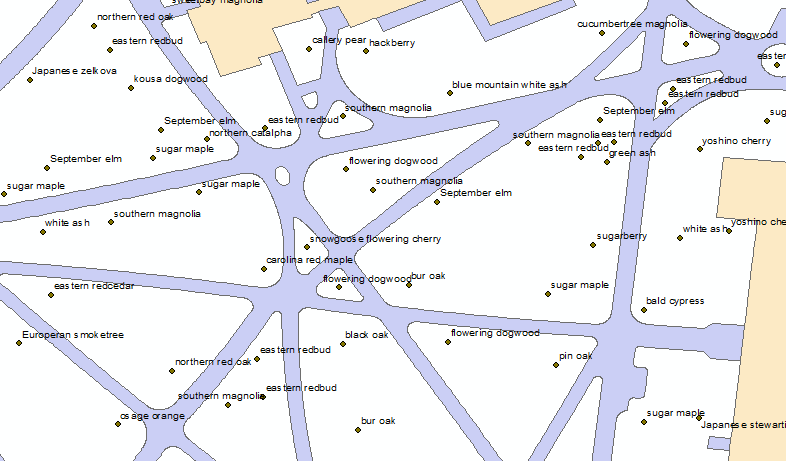
Because the arboretum consists of the entire Vanderbilt campus, its maintenance must be coordinated with the overall management of the buildings and grounds. This duty falls to the Campus Planning and Construction unit with the University Landscape Architect serving as the director of the arboretum. Each year about 150-200 new trees are planted on campus as part of landscaping for new construction and to replace trees that are lost. The location and taxonomic identity of over 6000 trees is documented in the tree layer of the campus GIS database.

PROGRESS OF THE ARBORETUM MEASURED AGAINST KIRKLAND HALL
Each year thousands of students and visitors to campus enjoy the results of 140 years of planning and planting of trees on the campus. Vanderbilt’s love and care of the trees in its arboretum should guarantee that they will be there for future generations.
References
1 Conkin, Paul K. 1985. Gone with the Ivy: A Biography of Vanderbilt University, University of Tennessee Press, Knoxville, p.19.
2 Hogge, Sharon. 1998. The Real Dirt: A History of the Vanderbilt Garden Club for Campus Beautification, The Vanderbilt Garden Club, Nashville, p. xix. Quote of Robert McGaw from 1983.
3 McGaw, Robert A. 1978. The Vanderbilt Campus: A Pictoral History, Vanderbilt University Press, Nashville, p. 16.
4 Vanderbilt Alumnus Magazine vol. 2 no. 5 (March 1917) p. 131 view original article
4a Letter from Holland McTyeire to Cornelius Vanderbilt, 1873 Nov. 24. Vanderbilt University Special Collections and University Archives.
5 Quoted in Wilcoxon, Reba (1981). How I got into trees — all the way from bur oaks to Big Al. Vanderbilt Register vol. II no. 3 (Sep. 4, 1981) p.9.
6 Wilcoxon, 1981.
7 The Trees of Vanderbilt: Seven Walks Through the Vanderbilt University Arboretum, 1994, p. 26.
8 Hogge, 1998, p. 5. Quote of Mrs. Arthur Ingersoll from 1922.
8a Conkin, 1985, p.197.
9 Hogge, 1998, pp. 7-8.
10 Hogge, 1998, p. 193. Quoting Aileen Bishop’s 1965 history of the Vanderbilt Garden Club.
11 Hogge, 1998, pp. 29-35.
12 Vanderbilt Garden Club Records, Vanderbilt University Special Collections Manuscript #473.
13 Vanderbilt Garden Club Records.
14 Hogge, 1998, pp. 35-36. Quoting a report by Mrs. S. R. Schealer.
15 Hogge, 1998, pp. 59.
16 Pendleton, Nicki. 1987. Tree Time at VU. Vanderbilt Register vol. VII no. 39. (June 26, 1987) p. 3.
17 Wilcoxon, 1981. See also p. 8 of The Trees of Vanderbilt
18 The Vanderbilt Register vol. VII no. 40 p.2 (July 10, 1987) corrects the erroneous value of one million dollars given in Wilcoxon, 1981.
19 McGaw, 1978, p. 27. Quoting 1893 innagural address of Chancellor James Kirkland.
20 Hogge, 1998, p. 40.
21 McGaw, 1978, p. 83.
22 Hogge, 1998, pp. 41-43.
23 McGaw, 1978, pp. 137-8.
24 Hogge, 1998, p. 60.
25 Doll, Gay Nelle. 2001. In the Company of Trees. Vanderbilt Magazine Winter/Spring 2001, p. 16-19.
26 Pendleton, 1987.
WRITTEN BY STEVE BASKAUF – 2014
THANKS TO THE STAFF OF VANDERBILT SPECIAL COLLECTIONS FOR THEIR HELP IN LOCATING MATERIALS IN THE ARCHIVES. SPECIAL THANKS TO PHIL NAGY FOR SEARCHING FOR AND SCANNING HISTORIC IMAGES IN THE ARCHIVE’S IMAGE COLLECTION.
